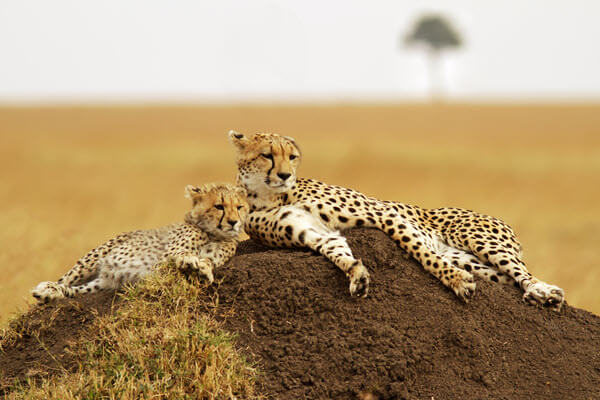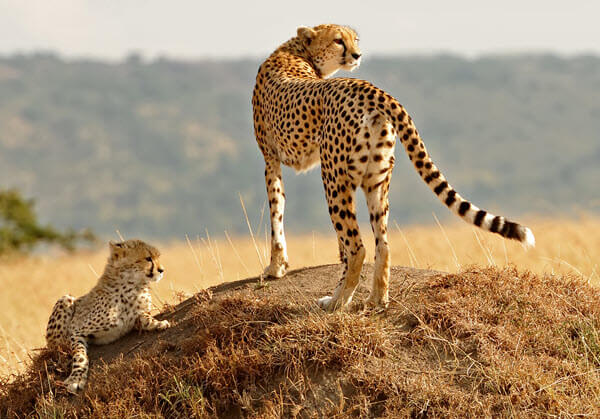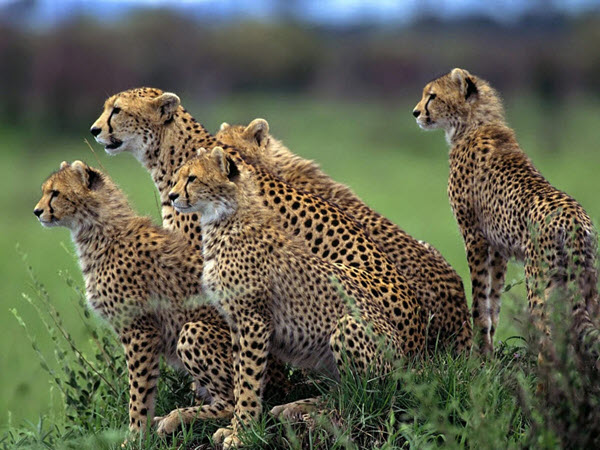The cheetah (Acinonyx jubatus) is a type of big cat that lives in Africa and Asia. Cheetahs prefer to live in open areas like savannahs where there is an abundance of prey, but can also be found in mountain terrain, grasslands and dense woodland.
Cheetahs hunt during the day to avoid competing for food with other carnivores such as leopards, lions and hyenas. They are the fastest animals on earth.
Like most wild cats, they have lost most of the land (75%) they used to inhabit.
Scientific Name: Acinonyx jubatus
Conservation Status: Vulnerable
Subspecies: There are currently four recognized subspecies of cheetah:
- Asiatic cheetah (Acinonyx jubatus venaticus) – Critically Endangered, only found in Iran.
- Northwest African cheetah (Acinonyx jubatus hecki)
- Northeast African cheetah (Acinonyx jubatus soemmeringii)
- Southeast African cheetah (Acinonyx jubatus jubatus)
Meaning of the name
The name cheetah comes from the Sanskrit word citrakayah (“citra” meaning displaying different spots and streaks, and “kaya” meaning body).
Interesting cheetah info
- The cheetah runs faster than any other land animal, reaching speeds of up to 75 mph.
- Cheetahs can accelerate from 0 to 62 mph in three seconds.
- Read more facts about cheetahs…
More about Cheetahs
History of cheetahs
It is believed the cheetahs began appearing in Africa between 7.5 and 26 million years ago. However more current research shows that their last common ancestor lived in Asia 11 million years ago. They could once be found throughout Africa and the Middle East. Today you can still find cheetahs in the wild in Algeria, Angola, Benin, Botswana; Burkina Faso, Central African Republic, Chad, Ethiopia, Iran, Kenya; Mali, Mozambique, Namibia, Niger, South Africa, South Sudan, Tanzania, Uganda, Zambia and Zimbabwe.
What cheetahs look like
 Cheetahs are with a long chest, tiny waist and small head. You can find them on our list of big cats.
Cheetahs are with a long chest, tiny waist and small head. You can find them on our list of big cats.
Adults can weigh up to 160 lbs. Their body is 43 to 59 inches in length, with a tail that is an additional 2 to almost 3 feet in length. The long tail helps the cheetah make quick turns when the cat is running. Males are somewhat bigger than cheetahs. The cats have strong back legs and muscles, which enable them to move extremely fast.
The cat’s fur is short and coarse, tan in color and covered with spots. At the end of the cat’s tail, the spots merge into several dark rings. Black stripes that look like tears run from the corner of the cheetah’s eyes to the side of its nose and mouth. Their spot patterns are unique for each cat. Because of their coloring, they are often mistaken for leopards. Rarely, the fur will be black, white or grey.
Cheetahs with larger black spots that have merged are called “king cheetahs.” Although once believed to be a separate subspecies, the King Cheetah is an African cat with a mutation in the pattern of its fur. They are rarely seen in the wild.
Where cheetahs live
Cheetahs inhabit the eastern and southern regions of Africa. There are also some remaining populations of Cheetah in Asia (Iran, Turkmenistan and Afghanistan). Depending on their location, a cheetah’s territory can range from 13 to over 60 square miles. Only males establish a territory, which they mark with urination. Females have home ranges and will often visit male territories.
How cheetahs communicate
Cheetahs purr, chirp, yowl, growl, hiss, spit and chur, but they do not roar. Chirping is the sound a cheetah mother will make when it is trying to find her cubs.
Hunting and food
The cheetah is known for being the world’s fastest land animal. It can reach speeds of up to 75 mph when racing across open land. The cat’s diet will vary depending on where it lives. They will eat hares, guinea fowl, gazelle, springbok (a type of antelope/gazelle) and the impala. Sometimes the cat will eat zebras and wildebeests.
Cheetahs will hunt in the early morning and at dusk when there is still some light, compared to other cats who are nocturnal hunters. This is because the cat hunts by sight instead of smell. They are not aggressive cats and their kill will often be taken by another predator.
Reproduction and lifespan
 Females will usually have had their first litter by the time they are two years old. Mating occurs all year long and, for the females, with different males. A female will have between three to five cubs at a time, but can also have as many as nine. Cubs are grey in color, with woolly hair (also called a mantle) that runs down their back.
Females will usually have had their first litter by the time they are two years old. Mating occurs all year long and, for the females, with different males. A female will have between three to five cubs at a time, but can also have as many as nine. Cubs are grey in color, with woolly hair (also called a mantle) that runs down their back.
The female will raise the cubs on her own. She will frequently change the location of her den to keep her cubs safe. Even so, a high percentage of cubs end up being killed by other predators.
At around 18 months, the mother will leave the cubs, and the siblings will form their own group. Within a few years, the young females with leave the group. The remaining young males will stay together for the rest of their life. Sometimes a single young male without siblings will join another group of males.
Cheetahs can live up to 12 years in the wild, and 20 years in captivity.
Cheetah conservation issues
There are an estimated 6,700 cheetahs living in the wild. Cheetah conservation threats include habitat loss and hunting. Cheetah populations are also becoming more fragmented. In some areas like Iran and North Africa, cheetah survival is also threatened by a reduction in prey.



If you look up “big cat” on Wikipedia, you will see the expanded definition, “tiger, lion, jaguar, leopard, and show leopard, as well as the non-pantherine cheetah and cougar.”
Cheetahs are actually in the small cat category along with Cougars (Pumas). They cannot roar and do purr. They are second largest of the small cats, 2nd only to the Cougar who is the largest of the small cats.
nice and complete information about cheeta।।।।